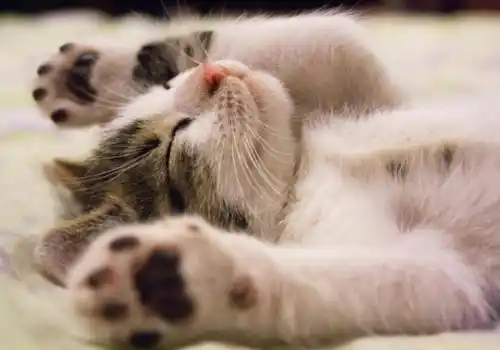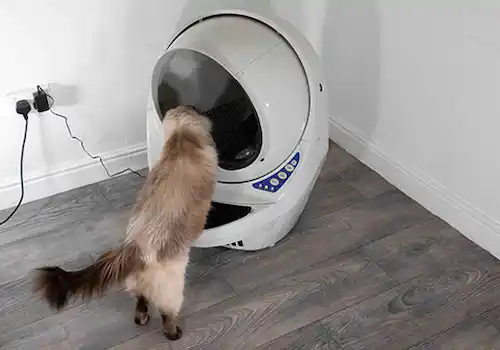What is causing your cat's skin irritation?
Cat itchy skin — it’s a common search term as owners try to get to the bottom of why their cat is scratching themselves. Skin problems in cats can be awful for cats and frustrating for owners to try to resolve. Here, we look at what causes skin conditions in cats and how they are diagnosed.
What’s causing your cat’s skin problem?
Skin problems are one of the most common reasons why cats visit their vet’s. Here are just a few of the conditions we regularly see:
- Pesky Parasites
Fleas and Flea Allergic Dermatitis (FAD)
These creepy crawlies are the number one cause of itchy cats! Adult fleas feed on cat blood before shedding their eggs into the environment (on to your carpet and sofa!). These eggs then develop into larvae that stealthily wait for a suitable host to pass by. As soon as they sense your pet (or you) within reach, they quickly hatch and jump aboard so they can continue their lifecycle.
Most cats with fleas are itchy but generally remain healthy. Small kittens carrying a large number of fleas can become unwell and develop life threatening anaemia (not enough red blood cells).
Some cats are allergic to fleas and even hosting just a few ‘visitors’ can cause flea allergic dermatitis (very inflamed, sore, bumpy skin).
There’s a baffling array of flea control products available but not all are effective and safe for your cat and the environment (house sprays may be toxic to fish and birds). If you have fleas in your home, it’s important to treat everywhere (especially bedding, carpets, and the cracks between floorboards). Speak to your veterinary team about the best, safest flea regime for your cat and home.
Ear mites (Otodectes cynotis)
Yet more creepy crawlies but this time in the ear! It’s sometimes possible to see ear mites without a microscope (look out for tiny, speedy white specks) but they mostly hide from the light deep within the ear canals.
Spot-on anti-parasite treatments are usually the best way to control ear mites (applied as per the instructions, not directly into the ear). Your vet may also prescribe ear drops or cleaners.
Harvest mites
Seen in late summer/autumn these tiny, orange dots attach on to cats’ toes and ear flaps. They are so itchy that some cats scratch too much and injure their own skin. Your vet will rid your cat of harvest mites and treat any skin damage too.
Ticks
Ticks are spider-like blood suckers with an enormous bottom! It’s easy to mistake ticks for other skin lumps because they bury their head under the skin while feeding (leaving their bum in the air).
It’s crucial to remove ticks properly as incomplete removal can cause an infection (your vet or vet nurse can show you how). Ticks may also carry disease so squeezing them isn’t a good idea either as it could push infected blood back into your cat.
Never apply a dog tick treatment to cats as they cause serious (often fatal) reactions. Your vet can give you safe, cat-only treatments.
- Skin Infections
Bacterial (pyoderma)
Any condition causing skin irritation can lead to a bacterial infection (pyoderma). Common causes include cat bites, injuries, parasites and allergies. Your vet will treat the underlying cause along with the infection (often cats need antibiotics and anti-inflammatories to settle their skin).
Yeast
Yeast infections in cats aren’t common but can cause sore, greasy, and sometimes smelly skin.
Fungal
The fancy term for this is ‘dermatophytosis’ although most people call it ‘ringworm’. Common signs include broken fur, hair loss, and scaly, inflamed skin (usually around the face and ears).
Your cat will need anti-fungal medicine along with a deep-clean of their environment (especially in catteries and multi-cat households). Humans can catch ringworm (small, red, itchy circles appear on the skin) so pay extra attention to hand hygiene if your cat catches it.
Viral
The cowpox virus can infect cats who are keen hunters of small rodents. The virus enters the body through wounds and scratches forming a small, red lump (usually on the face, neck, or leg). Over time, more crusty, red lumps and plaques (swollen, flat areas) appear.
Most cats recover within a few weeks although (rarely) immunocompromised cats (with a weakened disease-fighting system) or those on steroids could develop complications such as pneumonia. Severely affected cats may need hospitalising to support them while they recover.
FeLV (feline leukaemia virus) and FIV (feline immunodeficiency virus) can cause skin issues although it’s not something we commonly see.
- Chin acne
If your cat’s chin constantly looks dirty, they could have chin acne. Blocked hair follicles produce clusters of dark debris that collect on the skin around the chin and lips. There are many causes of chin acne including stress or allergies (sometimes plastic feed bowls are the culprit so use ceramic if possible).
If acne doesn’t bother your cat, then keeping the area clean may be all you need to do. If their chin-skin looks sore or infected, your vet can prescribe treatment to help.
- Allergies
Food
Both humans and animals can be intolerant to certain foods although we don’t always understand why. Cats may be allergic to the food itself or react to the chemicals and preservatives added to it. Your vet may recommend feeding your cat a special hypoallergenic diet for a couple of months to see if it helps. If your cat’s skin improves, they probably have food-responsive skin disease.
Atopy
Atopy is an allergy to substances in the environment and home, such as pollen and dust. Diagnosing atopy is tricky and relies on ruling out other causes of itchy, sore skin. Tests are available to check for allergies although the results aren’t always reliable.
There’s no cure for atopy, although medications can control and ease symptoms. It’s often trial and error to find what best helps your cat.
Insect bites and stings
Just as in humans, stings and bites are painful and can cause sudden swollen areas of skin. If your cat is particularly uncomfortable, your vet might prescribe medication to calm things down.
- Eosinophilic granuloma complex (EGC)
EGC is a type of inflammatory skin problem often caused by an underlying allergy. Signs of EGC usually follow one of the following patterns:
- Indolent ulcer — open sores on the edge of a cat’s upper lips.
- Eosinophilic plaque — large, raised, flat areas of skin often surrounded by fur loss (they can be very itchy and uncomfortable).
- Eosinophilic granuloma — patches of raised, red, thickened skin often associated with fur loss and ulceration.
Your cat may need skin biopsies (either taken by a needle or a small sample of skin), along with trialling allergy treatments and a special diet.
- Stress
A common sign of stress in cats is over grooming (just like when people chew their nails!) Even subtle lifestyle changes can upset your cat and cause them to spend too long licking and pulling at their fur. Along with alopecia (fur loss), over grooming can cause sore, infected areas of skin.
Your vet will rule out medical causes of over grooming before suggesting ways to reduce your cat’s general anxiety. (This is trickier than it sounds and often involves detailed detective work!)
- Skin cancer
The most common type of skin cancer affecting cats is a squamous cell carcinoma (SCC). Pale-eared cats who enjoy sunbathing are the most likely to develop SCC on their ears or nose. Surgery and specialist treatment can help but prevention is better than cure! Cat-friendly, high SPF sun cream is available to protect these sun-sensitive areas of skin.
Diagnosing cat skin disease
To help diagnose skin problems, your vet will consider every aspect of your cat’s life including: whether they go outdoors, what they eat, what other pets you have, the time of year, your parasite-control regime, their general health….and much more! Alongside this detailed history, your cat may need further tests:
Skin scrapes, hair plucks, tape strips, and coat brushings — a quick way to take samples and check for parasites.
Wet paper test — flea dirt will turn pink when in contact with a wet paper towel.
Fungal culture — a way to check for ringworm; fungal spores from infected fur samples will grow in special petri-dishes.
Wood’s lamp — some types of ringworm glow bright green when this UV light shines on to them.
Fine needle aspirate — cells from lumps and bumps are sucked through a needle then transferred on to microscope slides for analysis.
Skin biopsies — samples of skin are taken and sent to a lab for analysis by a veterinary pathologist.
It’s always best to speak to your veterinary team with any concerns you have about your cat’s health. Skin disease is so visual that your cat will need a detailed examination. We often take photos too as this is great way to record how well your cat is responding to treatment.
Dermatology terminology
These are terms your vet might use to describe your cat’s skin problem:
Abscess — a pus filled area beneath the skin.
Alopecia — fur loss (bald spots or thinning fur), most commonly due to over-grooming but sometimes an underlying problem causes fur to fall out.
Crusting — dried discharge (such as pus or blood) on the skin.
Cyst — a smooth, round skin-lump containing liquid or solid material.
Dermatitis — inflamed (red, sore, and often itchy) skin
Lesion — an area of abnormal skin (your vet will then describe the abnormality).
Otitis — ear inflammation or infection.
Plaque — a large area of raised skin with a flat surface.
Pruritus — itchiness.
Pus — a sign of infection; dead white blood cells, bacteria, and debris form white, yellow, or green liquid.
Pyoderma — skin infection (pus and flaky skin).
Scales/dandruff — loose flakes of skin
Tumour — cancerous or benign growths on the skin (just as elsewhere in the body).
Ulcer — an open sore on the surface of the skin







